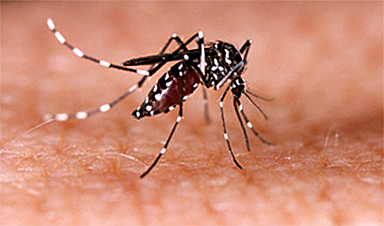Mosquitoes kill more people each year than any other animal. In 2023, the blood-sucking insects infected a reported 263 million people with malaria, leading to nearly 600,000 deaths, 80% of which were children.
Recent efforts to block the transmission of malaria have been stalled because mosquitoes have adapted resistance to insecticides and the parasites within mosquitoes that cause malaria have become resistant to drugs. These setbacks have been amplified by the COVID-19 pandemic, which impeded ongoing anti-malarial efforts.
Now, researchers at the University of California San Diego, Johns Hopkins University, UC Berkeley and the University of São Paulo have developed a new method that genetically blocks mosquitoes from transmitting malaria.
Biologists Zhiqian Li and Ethan Bier from UC San Diego, and Yuemei Dong and George Dimopoulos from Johns Hopkins University, created a CRISPR-based gene-editing system that changes a single molecule within mosquitoes, a minuscule but effective change that stops the malaria-parasite transmission process. Genetically altered mosquitoes are still able to bite those with malaria and acquire parasites from their blood, but the parasites can no longer be spread to other people. The new system is designed to genetically spread the malaria resistance trait until entire populations of the insects no longer transfer the disease-causing parasites.
“Replacing a single amino acid in mosquitoes with another naturally occurring variant that prevents them from being infected with malarial parasites – and spreading that beneficial trait throughout a mosquito population – is a game-changer,” said Bier, a professor in the UC San Diego Department of Cell and Developmental Biology (School of Biological Sciences). “It’s hard to believe that this one tiny change has such a dramatic effect.”
The newly developed system uses CRISPR-Cas9 “scissors” and a guide RNA to make a genetic cut at a precise location within the mosquito’s genome. It then replaces the unwanted amino acid that transmits malaria with the beneficial version that does not.
The system targets a gene that produces a protein known as “FREP1” that helps mosquitoes develop and feed on blood when they bite. The new system switches an amino acid in FREP1 known as L224 with a genetic alternate, or allele, called Q224. Disease-causing parasites use L224 to swim to the insect’s salivary glands, where they are positioned to infect a person or animal.
Dimopoulos, a professor in the Department of Molecular Microbiology and Immunology and the Johns Hopkins Malaria Research Institute (Bloomberg School of Public Health), and his lab tested strains of Anopheles stephensi mosquitoes, the main vector of malaria transmission in Asia. They found that the L224-to-Q224 switch could effectively block two different types of malarial parasites from reaching the salivary glands, thereby preventing infection.
The beauty of this approach lies in leveraging a naturally occurring mosquito gene allele. With a single, precise tweak, we’ve turned it into a powerful shield that blocks multiple malaria parasite species and likely across diverse mosquito species and populations, paving the way for adaptable, real-world strategies to control this disease.”
George Dimopoulos, Johns Hopkins University
In a range of follow-on tests, the researchers found that although the genetic switch disrupted the parasite’s infection capabilities, the mosquitoes’ normal growth and reproduction remained unchanged. Mosquitoes carrying the newly inserted variant Q224 exhibited similar fitness to those with the original L224 amino acid, a key achievement since the FREP1 protein plays an important role in the biology of the mosquito, which is separate from its role in being exploited by malarial parasites.
Similar to a gene-drive, the researchers created a technique for mosquito offspring to genetically inherit the Q224 allele and spread it throughout their populations, halting the transmission of malaria parasites. This new “allelic-drive” follows a comparable system recently engineered in the Bier Lab that genetically reverses insecticide resistance in crop pests.
“In that prior study, we created a self-eliminating drive that converts a population of fruit flies from being resistant to insecticides back to its native insecticide-susceptible state. Then that genetic cassette just disappears, leaving only a re-wilded insect population,” said Bier. “A similar phantom drive system could convert mosquito populations to carrying the parasite-resistant FREP1Q variant.”
While the researchers demonstrated the effectiveness of the L224-to-Q224 switch, they don’t yet fully grasp why this change works so efficiently. Ongoing research into how the Q224 amino acid blocks the parasite’s infection transit route is underway.
“This breakthrough is the result of seamless teamwork and innovation across institutions,” said Dimopoulos. “Together, we’ve harnessed nature’s own genetic tools to turn mosquitoes into allies against malaria.”
Li, Z., et al. (2025). Driving a protective allele of the mosquito FREP1 gene to combat malaria. Nature. doi.org/10.1038/s41586-025-09283-6.
News
Lower doses of immunotherapy for skin cancer give better results, study suggests
According to a new study, lower doses of approved immunotherapy for malignant melanoma can give better results against tumors, while reducing side effects. This is reported by researchers at Karolinska Institutet in the Journal of the National [...]
Researchers highlight five pathways through which microplastics can harm the brain
Microplastics could be fueling neurodegenerative diseases like Alzheimer's and Parkinson's, with a new study highlighting five ways microplastics can trigger inflammation and damage in the brain. More than 57 million people live with dementia, [...]
Tiny Metal Nanodots Obliterate Cancer Cells While Largely Sparing Healthy Tissue
Scientists have developed tiny metal-oxide particles that push cancer cells past their stress limits while sparing healthy tissue. An international team led by RMIT University has developed tiny particles called nanodots, crafted from a metallic compound, [...]
Gold Nanoclusters Could Supercharge Quantum Computers
Researchers found that gold “super atoms” can behave like the atoms in top-tier quantum systems—only far easier to scale. These tiny clusters can be customized at the molecular level, offering a powerful, tunable foundation [...]
A single shot of HPV vaccine may be enough to fight cervical cancer, study finds
WASHINGTON -- A single HPV vaccination appears just as effective as two doses at preventing the viral infection that causes cervical cancer, researchers reported Wednesday. HPV, or human papillomavirus, is very common and spread [...]
New technique overcomes technological barrier in 3D brain imaging
Scientists at the Swiss Light Source SLS have succeeded in mapping a piece of brain tissue in 3D at unprecedented resolution using X-rays, non-destructively. The breakthrough overcomes a long-standing technological barrier that had limited [...]
Scientists Uncover Hidden Blood Pattern in Long COVID
Researchers found persistent microclot and NET structures in Long COVID blood that may explain long-lasting symptoms. Researchers examining Long COVID have identified a structural connection between circulating microclots and neutrophil extracellular traps (NETs). The [...]
This Cellular Trick Helps Cancer Spread, but Could Also Stop It
Groups of normal cbiells can sense far into their surroundings, helping explain cancer cell migration. Understanding this ability could lead to new ways to limit tumor spread. The tale of the princess and the [...]
New mRNA therapy targets drug-resistant pneumonia
Bacteria that multiply on surfaces are a major headache in health care when they gain a foothold on, for example, implants or in catheters. Researchers at Chalmers University of Technology in Sweden have found [...]
Current Heart Health Guidelines Are Failing To Catch a Deadly Genetic Killer
New research reveals that standard screening misses most people with a common inherited cholesterol disorder. A Mayo Clinic study reports that current genetic screening guidelines overlook most people who have familial hypercholesterolemia, an inherited disorder that [...]
Scientists Identify the Evolutionary “Purpose” of Consciousness
Summary: Researchers at Ruhr University Bochum explore why consciousness evolved and why different species developed it in distinct ways. By comparing humans with birds, they show that complex awareness may arise through different neural architectures yet [...]
Novel mRNA therapy curbs antibiotic-resistant infections in preclinical lung models
Researchers at the Icahn School of Medicine at Mount Sinai and collaborators have reported early success with a novel mRNA-based therapy designed to combat antibiotic-resistant bacteria. The findings, published in Nature Biotechnology, show that in [...]
New skin-permeable polymer delivers insulin without needles
A breakthrough zwitterionic polymer slips through the skin’s toughest barriers, carrying insulin deep into tissue and normalizing blood sugar, offering patients a painless alternative to daily injections. A recent study published in the journal Nature examines [...]
Multifunctional Nanogels: A Breakthrough in Antibacterial Strategies
Antibiotic resistance is a growing concern - from human health to crop survival. A new study successfully uses nanogels to target and almost entirely inhibit the bacteria P. Aeruginosa. Recently published in Angewandte Chemie, the study [...]
Nanoflowers rejuvenate old and damaged human cells by replacing their mitochondria
Biomedical researchers at Texas A&M University may have discovered a way to stop or even reverse the decline of cellular energy production—a finding that could have revolutionary effects across medicine. Dr. Akhilesh K. Gaharwar [...]
The Stunning New Push to Protect the Invisible 99% of Life
Scientists worldwide have joined forces to build the first-ever roadmap for conserving Earth’s vast invisible majority—microbes. Their new IUCN Specialist Group reframes conservation by elevating microbial life to the same urgency as plants and [...]





















